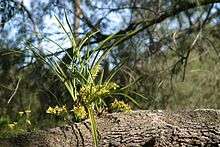Cymbidium suave
- "Snake orchid" redirects here. This name may also refer to the small bearded vanilla (Vanilla barbellata).
| Cymbidium suave | |
|---|---|
 | |
| Cymbidium suave | |
| Scientific classification | |
| Kingdom: | Plantae |
| (unranked): | Angiosperms |
| (unranked): | Monocots |
| Order: | Asparagales |
| Family: | Orchidaceae |
| Subfamily: | Epidendroideae |
| Genus: | Cymbidium |
| Species: | C. suave |
| Binomial name | |
| Cymbidium suave R.Br.[1] | |
Cymbidium suave (R. Brown 1810), or the snake orchid, is an Australian orchid species that is part of the genus Cymbidium which consists of 52 species.
It is one of the three epiphytic Cymbidium species that are located on the Australia continent. Flowers are similar to that of the species Cymbidium madidum, however, Cymbidium suave can easily be distinguished by the lack of pseudobulbs which are common to the genus. The two other species also located in eastern Australia include Cymbidium canaliculatum and the aforementioned Cymbidium madidum.
The pendulous flowers are light green to greenish brown. They are fragrant as indicated by its name. Several Australian orchid nurseries have stated that there exists an alba form and currently, Woolf Orchid Culture in Australia offers flasked seedlings. Depending on the plant and the environment it is in, Cymbidium suave has been known to produce several hundred flowers.
Growing Cymbidium suave can be quite a challenge. The lack of pseudobulbs and the extensive root network make its growing conditions an enigma to some. Some growers believe that there is a necessity for growing the plant in Eucalyptus bark, whereas others have argued that a traditional Cymbidium mix works just as fine. Planting Cymbidium suave in a hollowed log or in a PVC pipe has also been suggested. There is a general consensus that growers should attempt to avoid any disturbance of the plant's roots. If repotting is necessary, then it should be done in the spring during its growing season. The roots should be handled with much care.
References
- ↑ "Cymbidium suave". PlantNET - New South Wales Flora Online. Royal Botanic Gardens & Domain Trust, Sydney Australia. Retrieved 2008-11-08.